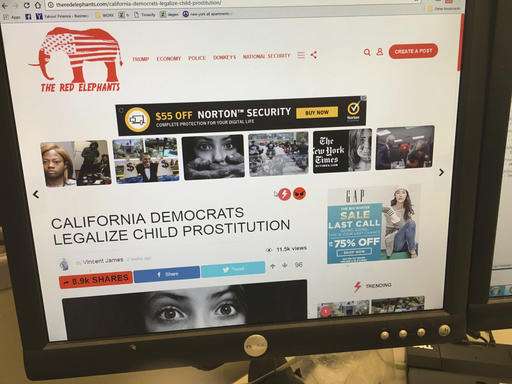Intentionally or not, big brands help fund fake news

Wittingly or not, major global corporations are helping fund sites that traffic in fake news by advertising on them.
Take, for instance, a story that falsely claimed former President Barack Obama had banned Christmas cards to overseas military personnel. Despite debunking by The Associated Press and other fact-checking outlets, that article lives on at "Fox News The FB Page," which has no connection to the news channel although its bears a replica of its logo.
And until recently, the story was often flanked by ads from big brands such as the insurer Geico, the business-news outlet Financial Times, and the beauty-products maker Revlon.
This situation isn't remotely an isolated case, although major companies generally say they have no intention of bankrolling purveyors of fake news with their ad dollars. Because many of their ads are placed on websites by computer algorithms, it's not always easy for these companies to steer them away from sites they find objectionable.
Google, the biggest player in the digital ad market, places many of these ads. The company says it bars ads on its network from appearing against "misrepresentative content"—its term for fake news—yet Google spokeswoman Andrea Faville acknowledged that the company had sold ads on the site with the Christmas-card story. Those ads vanished after The Associated Press inquired about them. Faville declined to comment on their disappearance.
ADS THAT GO WHERE THEY WILL
Media advertising was much simpler when companies had only to buy ad space in newspapers or magazines to reach readers in a particular demographic category. Digital ads, by contrast, can wind up in unexpected places because they're placed by automated systems, not sales teams, and targeted at individuals rather than entire demographics.
In effect, these ads follow potential customers around the web, where a tangle of networks and exchanges place them into ad slots at online publications. These middlemen have varying standards and levels of interest in helping advertisers ensure that their ads avoid controversy.
"A brand wouldn't have a real foolproof way of not getting on sites that have issues like this," said Joseph Galarneau, CEO of the New York City startup Mezzobit, which helps publishers and marketers manage advertising technology.
AUTOMATIC FAKE-NEWS FUNDING
Such automated ads are a major income source for fake news stories, which may have influenced voters in the U.S. presidential election. False stories can undermine trust in real news—and they can be dangerous. A widely shared but untrue story that pegged a Washington, D.C., pizzeria as part of a Hillary Clinton-run child sex trafficking ring led a man to fire a gun in the restaurant.
This largely invisible web of automated exchanges and ad networks funds millions of online sites, from niche, small-traffic blogs to professional news and entertainment sites with audiences in the tens of millions. By tracking web users to smaller sites, advertisers can reach them more cheaply than by limiting themselves to "premium" websites like the Washington Post, CBS or ESPN.
The megaphone of social media can give marginal sites a big lift. When a fake-news story spreads on Facebook, lots of people end up on the article's original site—and ads follow. The result: Big companies help fund some low-rent websites trafficking in conspiracy theories and other unverified claims, at the measly rate of a fraction of a cent per person per ad.
WHERE "FAKE" FALLS THROUGH THE CRACKS
While advertising technology vendors have safeguards in place to help mainstream advertisers avoid porn or hate speech, those don't always work for spoof news sites, said Marc Goldberg, CEO of Trust Metrics. Advertisers pay him to keep them off unwanted sites.
That's partly because "fake news" can be hard to define. And while advertisers can come up with "blacklists" of sites to avoid, there's no guarantee that ad-tech vendors farther down in the food chain will honor it, said Susan Bidel, an advertising analyst for research firm Forrester.
Many publishers and advertisers use Google's ad technology without having Google sell their ads. In those cases, Google's misrepresentative-content policy doesn't apply.
BRANDS IN A BIND
When the AP pointed out that a Chrysler Ram truck ad popped up on a story saying that the United Nations was making the U.S. pay reparations to African-Americans—it's not—Fiat Chrysler said it works with ad companies to scour individual sites and block them from loading its ads if it finds them "harmful."
An ad for would-be Amazon rival Jet.com, owned by Walmart, showed up on a misleading story claiming California had legalized child prostitution . The company said in an emailed statement that it has filters that stop its ads from loading "on these kinds of sites," but wouldn't provide more detail or explain its criteria.
Walgreens ads also popped up next to the child prostitution story on the site The Red Elephants, but the drugstore chain has since prevented its ads from appearing there, a company spokesman said.
A person who responded to an email sent to The Red Elephants declined to discuss the site's advertising, but insisted that the child-prostitution story was true. The person declined to provide their name.
A Financial Times spokeswoman said in an emailed statement that the media company was "frustrated" to learn that its ads appeared next to fake news like the Christmas-card story, saying the situation underscored the "very real risk" of using automated ads. "We think the ad technology ecosystem could, and should, do more to improve brand safety," she said.
Revlon declined to comment. A Geico spokeswoman said the company didn't know about its ad that ran on the spoof Fox News site.
© 2017 The Associated Press. All rights reserved.




















